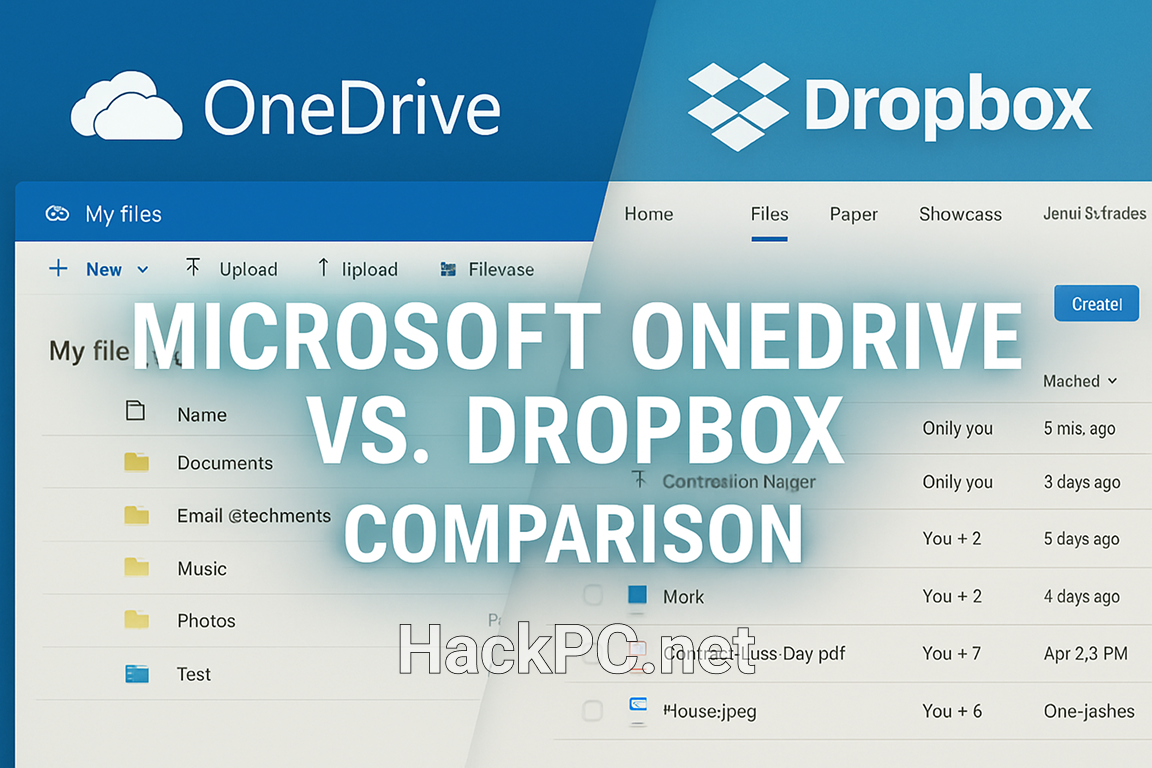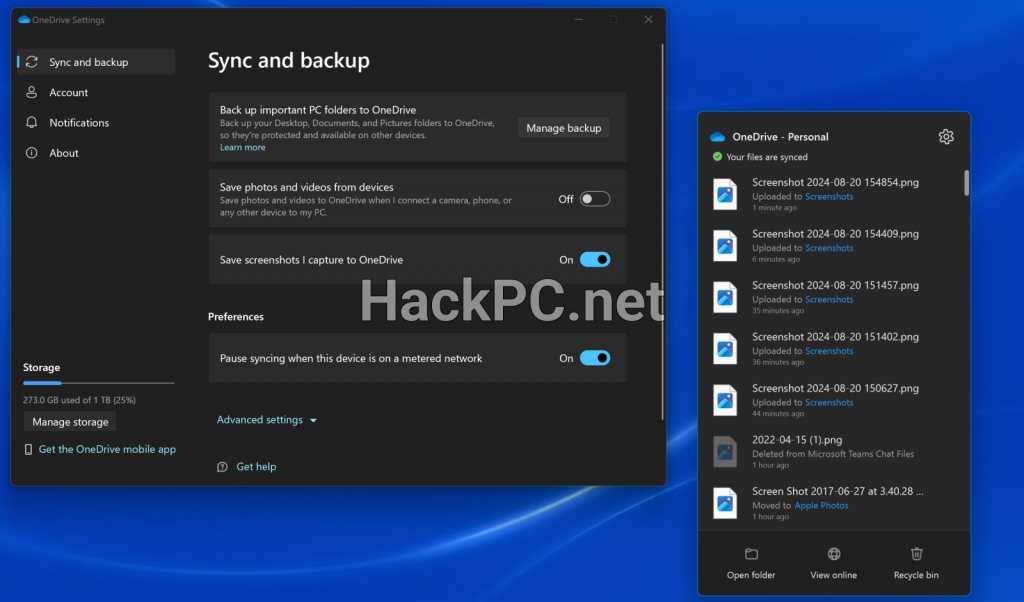
When it comes to choosing between cloud storage giants, the battle between Microsoft OneDrive and Dropbox represents more than just a simple storage decision—it’s about selecting an entire digital ecosystem that will shape how you work, collaborate, and manage your digital life. Having extensively tested both platforms across personal and enterprise environments, I’m here to dissect what really sets these cloud storage titans apart in 2025.
The Evolution of Cloud Storage: Beyond Simple File Hosting
Gone are the days when cloud storage meant simply dumping files into an online folder. Today’s cloud platforms have evolved into sophisticated productivity ecosystems, offering real-time collaboration, AI-powered search capabilities, and seamless cross-platform synchronization. Both Microsoft OneDrive and Dropbox have transformed dramatically from their humble beginnings, but their evolutionary paths reveal fundamentally different philosophies about what cloud storage should be.
Microsoft’s approach with OneDrive centers on deep integration within the Microsoft 365 ecosystem, creating a unified experience for users already invested in Office applications. Meanwhile, Dropbox has positioned itself as the Switzerland of cloud storage—neutral, versatile, and compatible with virtually everything, making it the go-to solution for creative professionals and diverse tech stacks.
Storage Capacity and Pricing Architecture: The Economics of Digital Space
OneDrive’s Strategic Pricing Model
Microsoft has crafted a pricing strategy that makes OneDrive incredibly attractive for those already considering Microsoft 365. The free tier offers 5GB of storage—more generous than Dropbox’s 2GB offering—providing enough space for essential document backup and basic file sharing needs.
The real value proposition emerges with paid plans. The Microsoft 365 Personal plan at $69.99 annually includes 1TB of cloud storage alongside the complete Office suite, making it exceptionally cost-effective for individuals needing both productivity tools and online storage. For families, the Microsoft 365 Family plan at $99.99 yearly provides 6TB total storage (1TB per person for up to six users), essentially breaking down to about $16.67 per user annually—remarkable value for comprehensive cloud backup solutions.
Business users find OneDrive for Business Plan 1 at $5 per user monthly delivers 1TB per user, while Plan 2 at $10 monthly offers unlimited storage for qualifying organizations. This scalability makes OneDrive particularly appealing for growing enterprises seeking flexible storage capacity plans.

Dropbox’s Premium-Focused Approach
Dropbox takes a different tack, positioning itself as a premium service with corresponding pricing. While the free 2GB tier feels restrictive in 2025’s data-heavy environment, the paid tiers reveal Dropbox’s focus on power users and creative professionals.
The Plus plan at $11.99 monthly provides 2TB of storage for individuals—double OneDrive’s standard offering. The Professional tier at $16.58 monthly jumps to 3TB with advanced features like Smart Sync, showcasing Dropbox’s commitment to users handling large media files and complex project workflows.
For teams, Dropbox Standard starts at $15 per user monthly with 5TB shared storage, while Advanced offers 15TB at $24 per user. The key differentiator? Dropbox allows 2TB file uploads on paid plans versus OneDrive’s 250GB limit—crucial for video editors, architects, and anyone working with massive files.
Performance Metrics: Speed, Sync, and Reliability
Synchronization Technology
My extensive testing reveals interesting performance characteristics. Dropbox’s block-level sync technology genuinely shines when handling large files with incremental changes. Instead of re-uploading entire files, it transfers only modified blocks, dramatically reducing sync times for frequently edited documents. This makes Dropbox particularly efficient for creative workflows involving large design files or video projects.
OneDrive has significantly improved its sync engine, now offering comparable speeds for most use cases. The Files On-Demand feature intelligently manages local storage, showing all files in Explorer while downloading them only when needed. However, OneDrive’s differential sync still lags behind Dropbox’s sophistication when dealing with massive files.
Real-World Upload/Download Speeds
In practical testing with a 1GB test file over standard broadband, both services achieved similar five-minute upload times. However, Dropbox’s LAN sync feature—automatically detecting and syncing files over local networks—provides substantial speed advantages for teams in shared office spaces.
OneDrive counters with better bandwidth management controls, allowing users to set specific upload/download limits. This granular control proves invaluable for remote workers managing limited internet connections or avoiding network congestion during critical video calls.
Collaboration Ecosystem: Where Productivity Meets Cloud Storage
OneDrive’s Microsoft 365 Integration
The seamless integration between OneDrive and Microsoft Office applications creates an unmatched collaborative environment for organizations already invested in Microsoft’s ecosystem. Real-time co-authoring in Word, Excel, and PowerPoint happens naturally, with changes automatically saved to OneDrive without user intervention.
Microsoft Teams integration transforms OneDrive into a central hub for team collaboration. Files shared in Teams channels automatically sync to SharePoint document libraries accessible through OneDrive, creating a unified workspace. The recent addition of AI-powered features like file comparison and intelligent search using Microsoft Copilot adds sophisticated capabilities for enterprise document management.
Dropbox’s Platform-Agnostic Approach
Dropbox excels through extensive third-party integrations, supporting over 300,000 connected apps. The platform works seamlessly with Google Workspace, Slack, Adobe Creative Cloud, and countless other tools, making it ideal for organizations using diverse software stacks.
Dropbox Paper provides a collaborative workspace for documentation and project planning, though it lacks the depth of Microsoft’s Office suite. However, Dropbox Replay revolutionizes creative collaboration, allowing teams to share, review, and approve video content with frame-accurate comments—functionality OneDrive simply doesn’t match.
Security Architecture: Protecting Your Digital Assets
Encryption and Data Protection
Both platforms implement AES 256-bit encryption for data at rest and TLS/SSL protocols for data in transit. However, neither offers zero-knowledge encryption for standard plans—meaning technically, employees could access your files under specific circumstances. Dropbox’s recent acquisition of Boxcryptor signals future zero-knowledge encryption for business plans, potentially giving it a significant security advantage.
OneDrive’s Personal Vault adds an extra security layer for sensitive files, requiring additional authentication like fingerprint or facial recognition. This feature, combined with automatic locking after periods of inactivity, provides enhanced protection for critical documents like financial records or legal documents.
Compliance and Business Security
For enterprise storage solutions, both platforms maintain impressive compliance certifications including SOC 2, ISO 27001, and HIPAA compliance. OneDrive benefits from Microsoft’s massive security infrastructure, including advanced threat protection and data loss prevention capabilities integrated across the Microsoft 365 suite.
Dropbox counters with features like remote device wipe, extended version history (up to 180 days on professional plans), and suspicious activity monitoring. The platform’s audit logs and granular permission controls provide IT administrators with comprehensive oversight of file access and sharing activities.
Mobile Experience and Cross-Platform Compatibility
OneDrive’s Device Integration
OneDrive’s mobile applications for iOS and Android offer robust functionality, including automatic photo backup, offline file access, and document scanning capabilities. The integration with Microsoft Lens transforms your phone into a portable scanner, automatically uploading scanned documents to designated OneDrive folders.
Windows users enjoy native File Explorer integration, making OneDrive folders indistinguishable from local storage. The recent addition of Samsung Gallery sync strengthens OneDrive’s position in the Android ecosystem, though iOS integration remains somewhat limited compared to iCloud.
Dropbox’s Universal Approach
Dropbox maintains consistent functionality across all platforms—Windows, macOS, Linux, iOS, and Android. The mobile apps excel at media handling, with automatic camera uploads, background uploading, and intelligent photo organization. The ability to stream video files directly from Dropbox without downloading them first proves particularly useful for mobile users managing limited device storage.
The desktop experience remains remarkably consistent across operating systems, with Smart Sync allowing users to see all files without consuming local storage—similar to OneDrive’s Files On-Demand but with broader OS support including Linux distributions.

Advanced Features: The Differentiators
OneDrive’s Unique Capabilities
OneDrive’s AI integration through Copilot represents a significant advancement in cloud storage intelligence. Features like automated file organization, content suggestions, and natural language search queries transform how users interact with their stored data. The ability to search text within images and scanned documents without manual tagging saves countless hours for information workers.
The Recycle Bin retention for 93 days (or 30 days for personal accounts) with detailed version history ensures accidental deletions rarely become disasters. Combined with ransomware detection and recovery capabilities, OneDrive provides robust data protection for business continuity.
Dropbox’s Creative Edge
Dropbox Transfer allows sending files up to 100GB (Professional plan) or 250GB (Business plans) to anyone, even non-Dropbox users—perfect for client deliverables or large media files. The transfer tracking shows when recipients download files, providing valuable insights for sales teams or creative agencies.
Dropbox Sign (formerly HelloSign) integration enables legally binding e-signatures directly within the platform. While OneDrive users must rely on third-party solutions or Adobe integration, Dropbox provides native signature workflows essential for modern business operations.
Real-World Use Cases: Choosing Your Champion
When OneDrive Dominates
Organizations deeply embedded in the Microsoft ecosystem find OneDrive indispensable. The seamless integration with Outlook for email attachments, SharePoint for intranet sites, and Teams for collaboration creates a unified experience that’s hard to beat. For businesses already paying for Microsoft 365, OneDrive essentially comes “free” with enormous value.
Educational institutions benefit from OneDrive’s generous storage allocations for students and educators, plus tight integration with Microsoft’s education tools. The ability to automatically save and sync OneNote notebooks, class assignments in Teams, and collaborative projects makes OneDrive the natural choice for academic environments.
Where Dropbox Excels
Creative agencies, media production companies, and design studios gravitate toward Dropbox for good reason. The superior handling of large files, extensive creative tool integrations, and features like Dropbox Replay for video review workflows address specific industry needs OneDrive doesn’t fully satisfy.
Organizations with diverse technology stacks—perhaps using Google Workspace for email but Adobe Creative Cloud for design—find Dropbox’s platform neutrality invaluable. The ability to integrate seamlessly with virtually any tool ensures Dropbox adapts to your workflow rather than forcing workflow changes.
The Verdict: Context Determines the Champion
After extensive testing and real-world usage, declaring an absolute winner oversimplifies the nuanced reality. OneDrive represents exceptional value for Microsoft-centric organizations, offering comprehensive cloud storage tightly integrated with productivity tools most businesses already use. The combination of competitive pricing, robust security, and seamless Office integration makes it nearly unbeatable for traditional office environments.
Dropbox, however, remains the superior choice for creative professionals, platform-diverse organizations, and anyone prioritizing maximum compatibility with third-party tools. The premium pricing reflects premium capabilities—superior large file handling, extensive integrations, and creative-focused features justify the cost for specific use cases.
Future Considerations: The Road Ahead
Both platforms continue aggressive development. OneDrive’s AI integration through Copilot promises increasingly intelligent file management and content creation assistance. Microsoft’s massive investment in AI infrastructure suggests OneDrive will become progressively “smarter” about organizing, finding, and utilizing stored content.
Dropbox’s acquisition strategy—including DocSend for document analytics and Boxcryptor for encryption—indicates a focus on specialized professional tools and enhanced security. The upcoming Dropbox Dash AI assistant aims to unify search across all your tools, potentially revolutionizing how we interact with distributed digital content.
Making Your Decision: A Practical Framework
Consider OneDrive if you:
- Already use or plan to use Microsoft 365 applications
- Prioritize cost-effectiveness with bundled productivity tools
- Need deep integration with Windows and Microsoft services
- Require comprehensive compliance certifications for regulated industries
- Want AI-powered features for document management and search
Choose Dropbox if you:
- Work with massive files exceeding 250GB
- Need maximum third-party application compatibility
- Collaborate with external partners using diverse platforms
- Require specialized creative collaboration tools
- Value platform independence and Linux support
The Bottom Line
The OneDrive versus Dropbox debate ultimately resolves to your specific ecosystem and requirements. OneDrive delivers unmatched value within Microsoft’s universe, while Dropbox provides superior flexibility and creative tools at a premium price. Rather than seeking the “best” solution, identify which platform’s strengths align with your workflow, budget, and collaboration needs.
In 2025’s hybrid work environment, many organizations find value in using both platforms—OneDrive for internal document management and Office collaboration, Dropbox for external sharing and creative projects. This dual-platform approach, while requiring careful data governance, leverages each service’s strengths while mitigating individual weaknesses.
Whether you choose OneDrive’s integrated ecosystem or Dropbox’s versatile platform, both services have evolved far beyond simple file storage into sophisticated collaboration platforms that fundamentally transform how we work with digital content. The winner isn’t the platform with the most features or lowest price—it’s the one that seamlessly integrates into your digital life, enhancing rather than complicating your productivity workflow.



Comments (0)